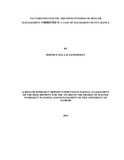| dc.description.abstract | The potential for mechanisms such as Health facility management committees (HFMCs) to meet their goals has been limited by wider decentralization challenges such as insufficient transfer in practice of decision-making power to local levels for a range of functions, lack of clarity in responsibilities at local levels, and broader factors such as the prevailing political context, and inadequate access to financial resources. The health sector in Kenya has undergone a major transformation due to amongst other factors, changing patterns of service delivery, County government regulations, technological innovations, service quality movements, and pressures to improve health care and health wages. Kenya’s new constitution, suggest a continued devolution of powers to senior managers in new County administrations and their hospitals. Alongside this shift there has been an increasing discourse in policy on the need for management skills, if not for professional management by health committees, but over the last twenty years this discourse has largely focused on senior management. The main objective of the study is to assess the factors that influence the effectiveness of health management committee in Machakos County, Kenya. The main variables are: health worker’s perception of public health committees, local county politics, poor health financing, and poor health staffing. This study contributes to theory building and policy development on the concept of healthcare planning and management. The study assumed that all the healthcare workers are fully aware of the devolution of healthcare and that all the respondents provided their honest perceptions. Some of the areas covered in the literature review include the theoretical anchorage of the study, overview of healthcare services, the conceptual framework and summary of knowledge gaps. Cross sectional descriptive design was adopted in this study because it involves collection of cross-sectional data at one point in time. The population for the purpose of this study is the health sector members in Machakos County who are 1350. The study specifically targeted the health workers and the County health committee members. The study sought to adopt stratified random sampling due to the non-uniformity of the population. The study adopted one set of a semi-structured questionnaire which was personally administered by the researcher in order to avoid unsolicited responses. The researcher obtained informed consent from any subject used in the study and ensured that all subjects participated voluntarily. The researcher used both qualitative and quantitative analysis after collection of data from the field. Frequency distribution tables, mean, standard deviation and percentages were adopted. The relationship between the variables was tested using the Pearson correlation technique. An important finding is that the explanatory variables in the model result in the direct influence on the effectiveness of health care management committee. Specifically, the findings suggest that local county politics was the most important variable influencing effectiveness of health management committee in Kenya, followed by health financing, then health staffing and health workers perception. This study recommends that: the government of Kenya to come up with policies to control the external factors that interfere with health care management with a possible measure to cushion the entire HMC from political turbulence. In terms of practice, the study recommends that the Ministry of health approaches the HMC with political goodwill, proper funding and adequate workforce | en_US |

